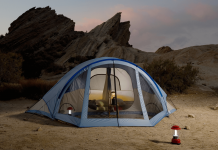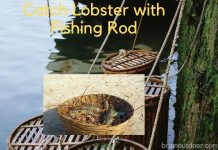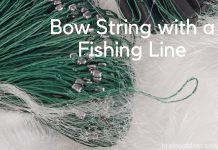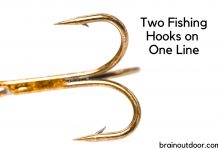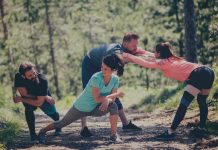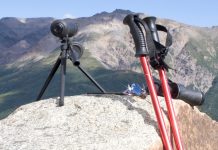Archery is a traditional hunting practice that is closely associated with bowhunting whitetail deer. Bowhunting provides hunters a deeper connection with their prey. You can explore the wildlife in proximity.
Do you want to go for an archery venture?
It’s time to pick up your bow, arrows and sharpen your bowhunting skills to hunt the exotic white-tailed deer.
Your living vicinity affects your bow hunting craving. White-tailed deers are a popular big game because of their highly adaptive feature.
The innocent wildlife beast is found in almost all US states. You can trace these deer in the southwestern deserts, northern forests, and coastal areas.
Read this guide to know all the bowhunting deer tips for a successful hunt.
Essential Bow Hunting Gear For White-tailed Deer Hunt

Hunting a white-tailed deer requires special equipment. The hunting market is full of modern and traditional gears, which make hunting exciting and easy. Your bowhunting experience and gears number increase hand in hand. However, as a beginner, there is not an extended list of the equipment to get started. Here is a short gear archery tips for beginners require for their venture.
- Ground blind or treestand
- Treestand safety harness
- Knife
- Backpack
- Camouflage clothing
- Wind checker
- Flashlight or headlamp
- Deep freezer
- Butchering equipment
Archery gear is the first stop when you decide to bow hunt a white-tailed deer. Practice with your gear to sharpen your skill for a fortunate hunt. Selecting equipment takes some professional help from the staff in the archery store. Take some archery lessons to learn the fundamentals, and remember practice is the key to success.
A Brief Introduction to White Tail Deer Superpowers

Deer are innocent but smart animals; they smell the hunters from a distance. They flee from a little noise or whoosh of an arrow. Their acute senses make them a challenging hunt for bowhunters. If their keen senses are their lifesaver as hunters, your knowledge is the key to a successful hunt.
Deers superpowers are their olfactory senses; their noses are their most outstanding defense.
Deer’s brains are their other superpower, which helps them decipher different smells. They interpret the faintest scents and run away from the spot spooking other deers as well.
How can you defeat the super hearing sense of white-tailed deer?
Rule number one is to avoid making any unnatural sounds. Deers are not alarmed by natural sounds like leaves rustling or acorn falling. However, a clink of bow bumping sends them running in another direction.
Deers’ superfast reaction helps them dodge fast arrows. A release sound of the bowstring is foreign to deers, and they decipher as threatening. The key to preventing a deer from scarring is to be patient and avoid any sound.
The Best White-Tailed Deer Bowhunting Spots
Whitetail deer are mysterious creatures; when you think you have figured their patterns, they take some unexpected turns. You can take the lead by focusing on the best deer hunting bow hotspots.
What is meant by hotspots of white-tailed deer?
Hotspots are places where there are high chances of spotting white-tailed deer. Experienced hunters have made a shortlist of best places for whitetails hunt,
Edges
Different habitats converge in the edges. Edges are spotted in between the recent clear cut and hardwood stand.
You can also spot an edge in between the field or swamp. You can find deers in adverse habitats because of the availability of food, shelter, and escape choices.
Pinch Points
Pinch points are the features of the land that channel deer movements. You can find these spots in between swamps, lakes, fields, and ponds.
A strip of woods is another great pinch point between areas. Deer prefer their pinch points because of their convenient routes, which provide them cover.
Bedding Areas
Bedding areas are those remote sites that have ample sunlight, little to none human activity, and thick cover. Bucks bed in the spots with their families; however, mature deers like to bed alone.
Feeding Areas
The ideal feeding areas for deers are clover and cornfields. Food plots, oak ridges, and berry patches are also visited by deer often. Deer feed on what is available is crucial for the hunter to know active feeding areas.
Sanctuaries
Sanctuaries are places where there is no human activity hence no hunting pressure. Some avid hunters leave the sanctuaries alone to protect the horde of deer. Sanctuaries are not popular hunting spots and occur in natural areas, private lands, or wildlife refuges.
Scrape Lines and Rubs
You can find lines of rubs and scrapes along the routes of the deer. Doe visits these spots to announce their presence by leaving their scents; it’s their way of showing they are ready to breed.
Knowledge of hunting spots proves beneficial for whitetail deer hunting. However, sites’ experience is not enough for a successful hunt; it also depends on the season. White-tailed deers habits fluctuate throughout the autumn season. It’s smart to alter your hunting spots with their changing manners.
Early Season Best Hunting Spots
Hunter can quickly determine the patterns of whitetail deers in the early season when they feed on fields. Deer follow a particular pattern of feeding, which includes leave before dawn and return before dark.
You can set up near the feeding field for bow hunt in early or evening or late afternoon when deers return for feeding. You can also hunt deer near their bedding spot when they return from feeding after dark,
You can find active deer movement near the edges where they have enjoyed the no hunting pressure phase for months. They become comfortable because of the absence of hunters for a long time and seen in the daylight.
Late Season Best Hunting Spot
The best part is deers bedding club, and feeding patterns remain the same by late season. Deers get exhausted from the rut and to survive winter’s wat in bulk. It’s smart to hunt in between the bedding and feeding places or other strategic spots between two zones.
If you are lucky to target a late-season sanctuary, it will leave you in good shape. Wite tail deers are smart and prey species. Their senses are always on high alert if their sens human movements in a specific place alter their traveling pattern. You can catch the bucks off guard by finding their sanctuaries.
A successful hunt requires extensive knowledge about whitetail deer patterns and their feeding or bedding spots. You have to be patient and attentive to catch these beautiful creatures.
Bowhunting Whitetail Deer Tips

Bowhunting whitetail deer is a challenging task because of the changing pattern of the buck. An experienced hunter alters its strategies with every season. Read all the bowhunting tips carefully that focus on the three periods of hunting seasons.
1. Early Season Bowhunting Tips
According to the experts, the early season is the best time for bowhunting whitetail deers. The fact is actual because deers are comfortable because of the absence of human activities from the wild for a long time. Here are some bow hunting tips bow hunter should consider when strategizing hunt in the early season
- It’s best to practice low-pressure bow hunting techniques to prevent spooking the deer in the early season,
- It’s recommended to get information through game cameras about the deer’s patterns and movements.
- Use gears that are unscented or with natural scents.
- Resist the urge of going out to the field often
- Formulate a solid hunting strategy before the opening of the early season
- With the early season approaching, look for the area with food types preferred by the deers.
- Deers feed on high sugar content foods before the rutting season lookout for the related fields.
- Carefully plan where to shoot a deer from different angles before the opening of the season.
2. Rut Season Hunting Tips
The three hunting season rut phases are the most challenging ones and need time to master the skills. Here are useful tips that can help the hunter in mastering bow hunting in the rut season.
- Hunting buck is the main center of every hunter, but it’s best to stalk to find them.
- Keep your eyes open and ears wide open to hear all sounds and grunts because rutting is a noisy season.
- Arrive at the field in the morning to listen to the calls in a clear atmosphere
3. Late Season Hunting Tips
Late hunting season demands the hunter all the knowledge and skills he has acquired throughout the season.
- Look for the food sources that are rich because deer look for rich food sources in winter.
- Late season make deer spook easily because of all hunting activities,
- It’s best to use low-pressure scouting to prevent the deer from abanding the site for a safer place.
Bowhunting whitetail deer require skills and knowledge that only comes with practice. Each season proves better than the previous of you use your mistakes to learn. Bowhunters have to use all the weapons in their arsenal To score a kill in the field. Observe, learn, make smart strategies, and the result will be a buck or doe in your bag.





